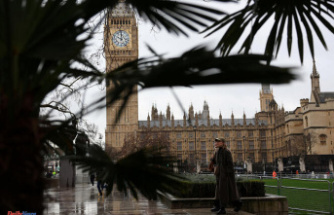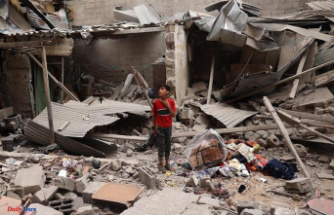Only Aisne, Ariège, Corrèze, Hauts-de-Seine, Paris and Seine-Saint-Denis are not affected by at least one prefectural decree limiting certain uses of water, according to the site of the government drought information, Propluvia.
The Propluvia map summarizing the different alert levels has turned red in a good part of the west of the Loire basin, but also in the Drôme, the interior of the Var or the Lot.
In these areas, only water withdrawals ensuring the exercise of priority uses are authorized: health, civil security, drinking water supply and sanitation. Harvesting for agricultural purposes is prohibited.
"We have a record for the number of departments with restrictions," noted the Ministry of Ecological Transition. The State has also mobilized the French Office for Biodiversity (OFB) to ensure control operations and compliance with drought decrees.
- "Moderation effort" -
The flow of the Loire is down sharply, to 129 m3 per second on July 20, against 475 m3 / s at the beginning of the month and the Loire-Atlantique has been placed on "drinking water alert" since July 20.
The Eaux et Rivières de Bretagne association pleads for even stricter restrictions by calling for "a serious effort to moderate consumption".
In Lorraine, the low flow of the Moselle has forced the Cattenom nuclear power plant since Friday to draw water intended to cool its installations in a neighboring reservoir.
In Franche-Comté, the situation is also catastrophic, to the point that several communes in the Doubs no longer have drinking water and must be supplied by tank trucks, according to the prefecture.
For its part, the Vaucluse has banned access to all of its forest areas for the day due to the high risk of fire.
Ditto in the Bouches-du-Rhône where the prefecture extended until Wednesday the closure of the 25 forest massifs of the department, including the very touristy Calanques National Park.
The Var or Haute-Corse have also cordoned off several massifs. The prefectures are calling for the adoption of preventive behavior so as not to risk causing a fire, but also to give the alert in the event of a fire starting.
Monday, the two fires which ravaged for twelve days more than 20,000 hectares of forest in Gironde were "fixed", announced the prefect of Gironde, Fabienne Buccio.
In Burgundy, the drought red alert only concerns the Beaune area (Côte d'Or), renowned for its wines, suggesting that the harvest will still be very early. The 2020 record could even be beaten, when the harvest started on August 16, unheard of since... 1556.
- "Dried in place" -
Traffic on the rivers and canals is also very disrupted: navigation is interrupted on part of the Burgundy Canal and in the Nancy region, while many barges on the Rhine are only loaded to a third of their capacity, for do not scrape the bottom of the river.
On the Canal du Midi, boat passages are grouped together at the locks, in order to save water. These measures, usually put in place after July 14, have been in force since the beginning of the month due to "drought conditions not seen for ten years", indicated Voies Navigables de France (VNF).
Agriculture is also suffering in areas a priori spared by the lack of water. In Pas-de-Calais, for example, Jean-Pierre Clipet, FDSEA manager, is worried about "dropping yields" while in Boulonnais, "colleagues (him) say it's worse than in 1976, they don't know how they will feed their animals this winter".
The fauna is also sticking out its tongue, with water points "which are becoming scarce", forcing the animals "to go much further", which increases the "risk of collision on a road" or exhaustion at the search for water, warns Jean-Baptiste Decotte, of the LPO Auvergne-Rhône-Alpes.
"We had a big impact this year on the reproduction of amphibians and dragonflies, water beetles," he observes. "All species are really badly affected with larvae that have dried up on the spot".












